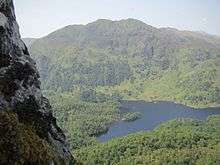Trossachs
Coordinates: 56°13′52″N 4°24′18″W / 56.231°N 4.405°W



The Trossachs (![]() listen ; Scottish Gaelic, Na Trosaichean) is a small woodland glen in the Stirling council area of Scotland. It lies between Ben A'an to the north and Ben Venue to the south, with Loch Katrine to the west and Loch Achray to the east. However, the name is used generally to refer to the wider area of wooded glens and braes with quiet lochs, lying to the east of Ben Lomond. The Lake of Menteith, lies about six miles (10 km) to the south east of the glen, on the edge of the Trossachs area.
listen ; Scottish Gaelic, Na Trosaichean) is a small woodland glen in the Stirling council area of Scotland. It lies between Ben A'an to the north and Ben Venue to the south, with Loch Katrine to the west and Loch Achray to the east. However, the name is used generally to refer to the wider area of wooded glens and braes with quiet lochs, lying to the east of Ben Lomond. The Lake of Menteith, lies about six miles (10 km) to the south east of the glen, on the edge of the Trossachs area.
Popularity
The scenic charms of the area came to popularity with Sir Walter Scott's 1810 poem The Lady of the Lake, extending his romantic portrayal of Scotland's past from border ballads to poems of a medieval past rich in chivalry and symbolism. The poem gives a roll call of Trossachs place names, the lady herself being found on Loch Katrine. Scott followed up with his 1817 historical novel Rob Roy romanticising the outlaw cattle thief Raibert Ruadh born by Loch Katrine and buried at nearby Balquhidder.
Tourism and development
The Trossachs Hotel was built on the north bank of Loch Achray in response to the growing number of tourists visiting the region. The building now functions as the Tigh Mor Trossachs holiday apartments, owned by the Holiday Property Bond (HPB).
In 1859, a dam was built at the eastern end of Loch Katrine and connecting aqueducts were added to as part of a new main water supply to Glasgow. At the expense of the Glasgow water company, Queen Victoria had a holiday house built overlooking the loch. The house, Royal Cottage, later became accommodation for the employees of Scottish Water. A steamer service was introduced, and the SS Sir Walter Scott, launched in 1900, remains in operation. The area is now part of the Loch Lomond and the Trossachs National Park, and remains popular with walkers and cyclists. Scenic boat rides on Loch Katrine are also popular with visitors.

The small town of Callander and the village of Aberfoyle lie at the edge of the Trossachs. Lake of Menteith, situated near Aberfoyle, is a fishing destination that features the ruins of Inchmahome Priory on one of its islands, Inchmahome, where Mary, Queen of Scots was taken as a child before being taken to France for her protection.
Ruskin connection
The leading Victorian art critic John Ruskin (1819–1900) and the Pre-Raphaelite painter John Everett Millais (1829–1896) spent the summer of 1853 together at Glenfinl.as in the Trossachs.[1] Millais started a painting of John Ruskin during the visit, which he finished the following year. The painting is held in a private collection, but was on show at an exhibition on the Pre-Raphaelites at Tate Britain in London during 2004.[2] John Ruskin himself was especially interested in the rock formations in the area and undertook his own studies of these.
References
- ↑ Ruskin and Millais at Glenfinlas, The Burlington Magazine, Vol. 138, No. 1117, pages 228–234, April 1996. (Accessed via JSTOR, UK.)
- ↑ Pre-Raphaelite Vision: Truth to Nature, Tate Britain, London, UK, 12 February – 3 May 2004.
External links
| Wikimedia Commons has media related to Trossachs. |
| Wikisource has the text of the 1911 Encyclopædia Britannica article Trossachs, The. |
- Loch Lomond and the Trossachs National Park
- Trossachs History and the people who contributed to it
- The Trossachs in film & television
- Trossachs Hotel - HPB
- Loch Katrine in the Trossachs
- What to see and where to stay in the Trossachs
- Engraving of a view of the Trossachs by James Fittler in the digitised copy of Scotia Depicta, or the antiquities, castles, public buildings, noblemen and gentlemen's seats, cities, towns and picturesque scenery of Scotland, 1804 at National Library of Scotland